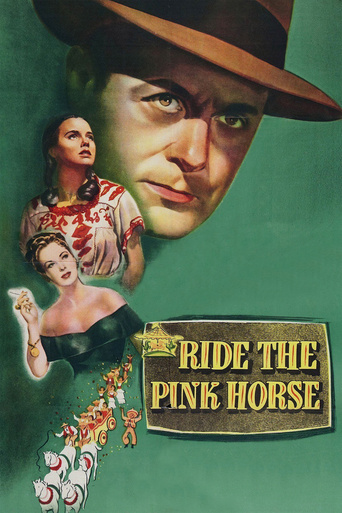

Having seen this many years ago and having been rather confused by it. I wondered if waiting years to see it again if it would come together for me. Unfortunately, it has not, becoming even more of a mystery than before. I wondered if the issues I had with it before were my issue, but ultimately, the conclusion that I came to is the fact that it strives for new wave artistry but simply ends up being pretentious. Robert Montgomery, so good on "Lady in the Lake", tried again in the film noir genre and managed to turn this into a cult classic. I am not a part of that cult.Arriving by Greyhound in a border town during a fiesta, Montgomery finds intrigue in local corruption, finding an amigo on jolly Thomas Gomez and a pest in young Wanda Hendrix. Other corrupt characters give only moderate clues over what is going on, and it takes a lot of patience to get to the conclusion to really put it all together.Andrea King plays one of the great femme fatales of all time, and where she is going remains an impressive mystery. A scene with villains beating up Gomez as children observe it from their seats on a twirling carousel, is one of the great visuals of the noir genre.Perhaps the problem also lies in the setting. Rural border towns are creepy looking and dark at night and I really longed for a city setting to make this feel like a desolate area where occasional crowd scenes could bring on a flash of excitement. Montgomery is a rather cold, unemotional anti-war, with Hendrix following him around non- stop like some unwanted guardian angel. Dry and humorless, this drags slightly and I kept longing for something to happen. Fred Clark, on his debut, makes an intriguing sleeve,leading him to a lengthy career of playing snarky WASPS. Some interesting photography gives the appropriate atmosphere, but overall, this is a highly overrated bore.
... View MoreThis is a classic pseudo film noir. It means to emulate, but not necessarily be, a true film noir.Robert Montgomery is excellent and believable as a man driven to revenge the death of his war time pal.The scenes with Wanda Hendrix as, in turns, a guileless teen, a knowing friend and a woman who 'sees things' are taut and dramatic. There are a few moments of humor there too.Mr Montgomery's direction is both intelligent and convincing. There are moments of drama. Moments of near pathos. Moments of comedy. Moments of boredom - from the characters, not the audience.The 'Fed' and 'Pancho' the carousel owner are interesting and engaging characters. Not hollow or cardboard cutouts that one might see in some films.All in all it is a very enjoyable film and a must see for those that appreciate both the acting skills and the directorial skills of Mr. Robert Montgomery.
... View MoreI was in the process of reading this book and then started watching a movie without knowing what the movie was. It was deja vu all of the sudden. It turned out to be this movie. I think that Robert Montgomery did a great job of capturing the character that was in the book. Tough but naive at the same time. A very good noir film that should get more play and recognition.The dark atmosphere,the craziness of the music and the partying in the background all the time as the story unfolds. Maybe I had a leg up reading the book almost first. It's very rare when I think a movie based on a book is just as good as the book. I felt sympathy for Robert Montgomery's character. All the time thinking he was going to lose to the cheats. He had his own principals and stuck to them.Can't say enough.Good movie.
... View MoreThis is a relatively unknown film despite thomas gomaz being nominated for best supporting actor. What a shame, since this is a really great film. Although i do think that this is a pretty stupid title. It was also robert montgomery's second film as star and director after 1946's lady in the lake, in which he played phil marlowe.
... View More